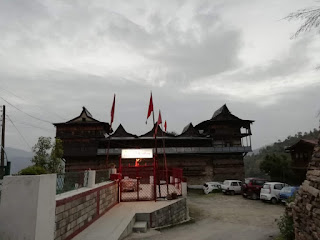You know what is the good part about being an anthropology
student? You can indulge yourself in a surprising array of fields without
actually deviating from the main discipline. So while I was out there in the
little town of Junga, doing an internship in forensics I did not let my
archaeological outlook subside and went to this chief attraction of the town-
The Old Junga Palace, what the locals addressed as “Purana Mahal”.
 |
| Frontage of the Old Junga Palace |
What I expected to be a significant monument with huge stone walls actually
turned out to be an ancient half-wooden palace falling into gentle ruins. Before
getting into the very details of how the palace looks like? Who ruled the place? etc.., it is first important for the readers to
understand that this blog only intends to blow the dust off of the history of
the locale and introduce this badly conserved site to the inquisitive minds of
explorers and researchers.
Running through the daily routine of working on rotten
human remains, hair and blood samples, dealing with the terms and techniques of
forensic science and what not, on a fine day around 5 in the evening I finally decided
to go and see what the buzz was all about. Accompanied by 4 others, strolling
around the town, asking people for the directions, we made it to the fort at
dusk. This required a special mention
here as the quality of pictures I’m putting up in this blog is not good enough
and before anyone brings this up, you should know that one; it was late time of
the day and two; I was not carrying any high-resolution digital camera but a phone which could capture pictures only of a doable standard. This is the best I could get in
those dark hours.
 |
| The Entrance turned into a parking space. |
 |
| An outworn inhabited portion of the palace |
One can spot the Old Junga Palace standing tall
and firm on the other end of the route. The road continues for another half
kilometer before one finally reaches the aged and deserted palace. The outmoded
building is situated in the older part of Junga which has comparatively a very small percentage
of population left.
Junga was the capital of the Princely state of Keonthal during the British
Rule. The state was ruled by the Rajputs of Sen (Chandrabansi)
Dynasty, whose successors are still known to hold the power. The present Ruler
and 78th Raja of Keonthal, Raja Veer Vikram Sen still lives in the
town but the family shifted from the old palace long ago into their New
Residency at the later established settlement of New Junga. The Old palace is
left to face the ravages of time with no proper conservation of this
architectural glory.
 |
| The deserted courtyard |
 |
| Façade running into the shadows of inexistence |
 |
| Wooden projecting balconies |
The
cracked and leaning wooden windows, fallen roofs, broken staircase, sagging and
buckling floors, have tales to tell but only the winds to hear them. The indigenous architecture of the palace, the
artisanal wooden cravings on the Doors and windows, the slate roofs, projecting
wooden balcony façade, all give a perfect representation of the “Kath-khuni
building style”, a timeless way of building settlements in the rough and rugged
terrains of Himachal Pradesh. The place demands exploration and conservation in
order to preserve what otherwise will be lost to the ages.
Nature is known to
catch up with even the most firmly standing foundation and
if we persist in staying ignorant of our own heritage, the age old beauty would
soon be brought down to dust, leaving no trails to track and no past to ponder upon.
P.S - Given below are some pictures of what the Palace would have looked like, had I been provided with a better camera and a perfect lighting. Also, these photographs were taken from a few years ago and bear witness to what today stands as the greatest threat to the Indian heritage- Ignorance.
 |
| Projecting balconies |
 |
| The same outworn inhabited portion of the palace |












"I truly appreciate the effort you put into this content. It’s both informative and engaging. Keep posting more helpful articles like this!"
ReplyDeleteWhite Agate stone
My father like to enjoy the cheap weekend getaways from san francisco. He is always spend the best time there and explore the beautiful attractions here.
ReplyDelete